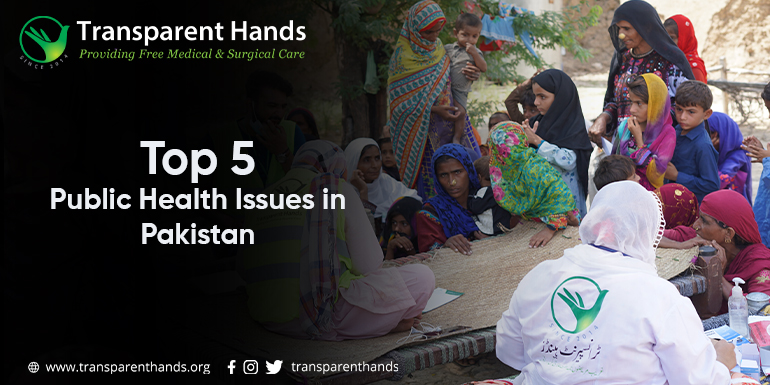Top 5 Public Health Issues in Pakistan

Pakistan is a developing country with a population of over 220 million people, and like many developing nations, it faces significant public health issues. These problems have a severe impact on the health and well-being of its citizens, especially the poor ones because of the financial constraints. In this article, we will discuss the common public health issues in Pakistan and provide examples of how they affect the country’s population.
The Public Health Issues in Pakistan
- Malnutrition
- Infectious Diseases
- Maternal & Child Health
- Non-communicable Diseases
- Mental Health
Without further ado, let’s discuss the health issues in the country.
1. Malnutrition
Malnutrition is a major health issue, particularly among children under the age of 5. According to UNICEF, Pakistan is among the countries with the highest rate of stunted growth in the world, with around 40% of children under the age of 5 being affected. Malnutrition is caused by poverty, lack of education, and limited access to healthcare facilities. As a result, children in Pakistan suffer from a wide range of health problems, including stunted growth, weakened immune systems, and developmental delays.
2. Infectious Diseases
Infectious diseases such as tuberculosis, malaria, and hepatitis are among the prevalent public health issues in Pakistan. Poor hygiene, lack of access to clean water, and inadequate sanitation cause these diseases For example, in the rural areas of Pakistan, people often use contaminated water sources, leading to the spread of waterborne diseases. According to the World Health Organization (WHO), Pakistan has one of the highest rates of tuberculosis in the world, with over 500,000 new cases reported each year.
3. Maternal & Child Health
Pakistan has one of the highest maternal and child mortality rates in the world. This is primarily due to poor access to healthcare facilities, lack of education, and poverty. Women in Pakistan often give birth at home, without the assistance of trained healthcare professionals, leading to a high rate of maternal mortality. Additionally, children in Pakistan often suffer from preventable illnesses, such as pneumonia and diarrhea, due to poor nutrition and lack of access to healthcare.
4. Non-communicable Diseases
Non-communicable diseases such as diabetes, hypertension, and heart disease are becoming increasingly common in Pakistan. This is due to changing lifestyles, lack of exercise, and unhealthy diets. For example, in urban areas of Pakistan, people often consume unhealthy fast food and sugary drinks, leading to an increase in obesity and related health problems. A study predicts that the prevalence of diabetes in Pakistan will double in the next decade.
5. The Mental Health
Mental health is a significant public health issue in Pakistan, but it is mostly overlooked. Mental health disorders such as depression, anxiety, and post-traumatic stress disorder (PTSD) are prevalent in the country, but people often do not seek help due to social stigma. For example, people who have experienced violence or trauma, such as those who have been affected by terrorism, may suffer from PTSD. However, due to the stigma surrounding mental health, many people do not seek help, leading to a high rate of untreated mental health disorders.
EndNote
In conclusion, Pakistan faces numerous public health issues that have a severe impact on the health and well-being of its citizens. A range of factors, including poverty, lack of education, and inadequate healthcare infrastructure, cause these issues. To address these issues, the government of Pakistan must invest in public health infrastructure, promote education and awareness, and improve access to healthcare facilities. It is essential to tackle these public health issues to improve the health and well-being of the people of Pakistan.










Leave Your Comments